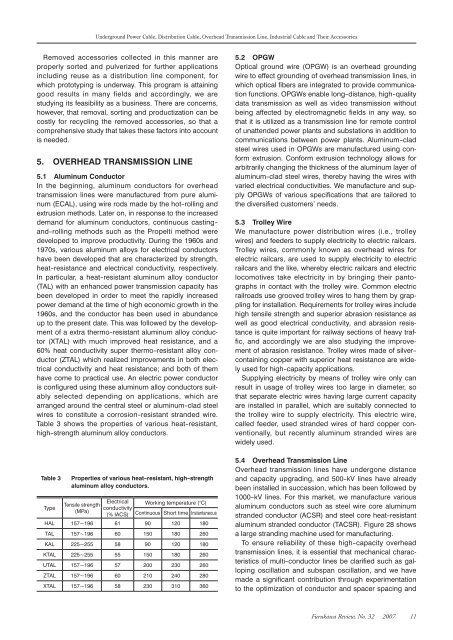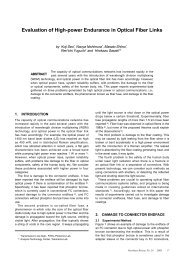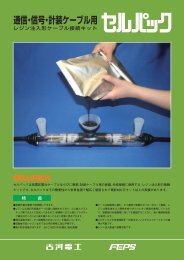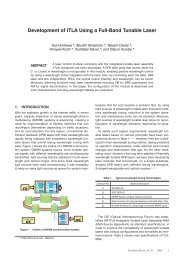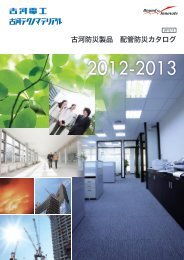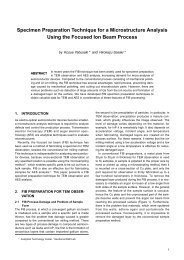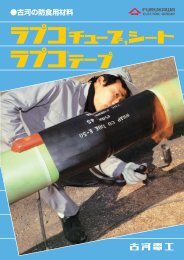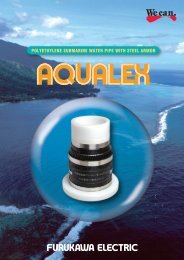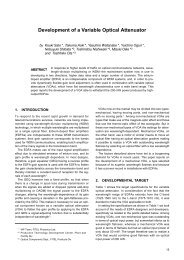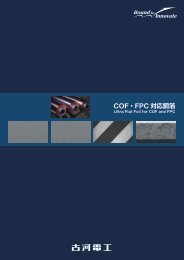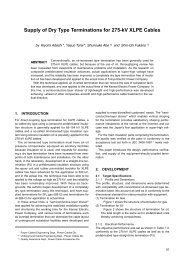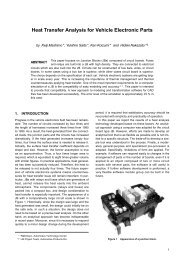Underground Power Cable, Distribution Cable, Overhead
Underground Power Cable, Distribution Cable, Overhead
Underground Power Cable, Distribution Cable, Overhead
Create successful ePaper yourself
Turn your PDF publications into a flip-book with our unique Google optimized e-Paper software.
<strong>Underground</strong> <strong>Power</strong> <strong>Cable</strong>, <strong>Distribution</strong> <strong>Cable</strong>, <strong>Overhead</strong> Transmission Line, Industrial <strong>Cable</strong> and Their Accessories<br />
Removed accessories collected in this manner are<br />
properly sorted and pulverized for further applications<br />
including reuse as a distribution line component, for<br />
which prototyping is underway. This program is attaining<br />
good results in many fields and accordingly, we are<br />
studying its feasibility as a business. There are concerns,<br />
however, that removal, sorting and productization can be<br />
costly for recycling the removed accessories, so that a<br />
comprehensive study that takes these factors into account<br />
is needed.<br />
5. OVERHEAD TRANSMISSION LINE<br />
5.1 Aluminum Conductor<br />
In the beginning, aluminum conductors for overhead<br />
transmission lines were manufactured from pure aluminum<br />
(ECAL), using wire rods made by the hot-rolling and<br />
extrusion methods. Later on, in response to the increased<br />
demand for aluminum conductors, continuous castingand-rolling<br />
methods such as the Propelti method were<br />
developed to improve productivity. During the 1960s and<br />
1970s, various aluminum alloys for electrical conductors<br />
have been developed that are characterized by strength,<br />
heat-resistance and electrical conductivity, respectively.<br />
In particular, a heat-resistant aluminum alloy conductor<br />
(TAL) with an enhanced power transmission capacity has<br />
been developed in order to meet the rapidly increased<br />
power demand at the time of high economic growth in the<br />
1960s, and the conductor has been used in abundance<br />
up to the present date. This was followed by the development<br />
of a extra thermo-resistant aluminum alloy conductor<br />
(XTAL) with much improved heat resistance, and a<br />
60% heat conductivity super thermo-resistant alloy conductor<br />
(ZTAL) which realized improvements in both electrical<br />
conductivity and heat resistance; and both of them<br />
have come to practical use. An electric power conductor<br />
is configured using these aluminum alloy conductors suitably<br />
selected depending on applications, which are<br />
arranged around the central steel or aluminum-clad steel<br />
wires to constitute a corrosion-resistant stranded wire.<br />
Table 3 shows the properties of various heat-resistant,<br />
high-strength aluminum alloy conductors.<br />
Table 3 Properties of various heat-resistant, high-strength<br />
aluminum alloy conductors.<br />
Type<br />
Electrical<br />
Tensile strength<br />
Working temperature (°C)<br />
conductivity<br />
(MPa)<br />
(% IACS) Continuous Short time Instantaneous<br />
HAL 157~196 61 90 120 180<br />
TAL 157~196 60 150 180 260<br />
KAL 225~255 58 90 120 180<br />
KTAL 225~255 55 150 180 260<br />
UTAL 157~196 57 200 230 260<br />
ZTAL 157~196 60 210 240 280<br />
XTAL 157~196 58 230 310 360<br />
5.2 OPGW<br />
Optical ground wire (OPGW) is an overhead grounding<br />
wire to effect grounding of overhead transmission lines, in<br />
which optical fibers are integrated to provide communication<br />
functions. OPGWs enable long-distance, high-quality<br />
data transmission as well as video transmission without<br />
being affected by electromagnetic fields in any way, so<br />
that it is utilized as a transmission line for remote control<br />
of unattended power plants and substations in addition to<br />
communications between power plants. Aluminum-clad<br />
steel wires used in OPGWs are manufactured using conform<br />
extrusion. Conform extrusion technology allows for<br />
arbitrarily changing the thickness of the aluminum layer of<br />
aluminum-clad steel wires, thereby having the wires with<br />
varied electrical conductivities. We manufacture and supply<br />
OPGWs of various specifications that are tailored to<br />
the diversified customers’ needs.<br />
5.3 Trolley Wire<br />
We manufacture power distribution wires (i.e., trolley<br />
wires) and feeders to supply electricity to electric railcars.<br />
Trolley wires, commonly known as overhead wires for<br />
electric railcars, are used to supply electricity to electric<br />
railcars and the like, whereby electric railcars and electric<br />
locomotives take electricity in by bringing their pantographs<br />
in contact with the trolley wire. Common electric<br />
railroads use grooved trolley wires to hang them by grappling<br />
for installation. Requirements for trolley wires include<br />
high tensile strength and superior abrasion resistance as<br />
well as good electrical conductivity, and abrasion resistance<br />
is quite important for railway sections of heavy traffic,<br />
and accordingly we are also studying the improvement<br />
of abrasion resistance. Trolley wires made of silvercontaining<br />
copper with superior heat resistance are widely<br />
used for high-capacity applications.<br />
Supplying electricity by means of trolley wire only can<br />
result in usage of trolley wires too large in diameter, so<br />
that separate electric wires having large current capacity<br />
are installed in parallel, which are suitably connected to<br />
the trolley wire to supply electricity. This electric wire,<br />
called feeder, used stranded wires of hard copper conventionally,<br />
but recently aluminum stranded wires are<br />
widely used.<br />
5.4 <strong>Overhead</strong> Transmission Line<br />
<strong>Overhead</strong> transmission lines have undergone distance<br />
and capacity upgrading, and 500-kV lines have already<br />
been installed in succession, which has been followed by<br />
1000-kV lines. For this market, we manufacture various<br />
aluminum conductors such as steel wire core aluminum<br />
stranded conductor (ACSR) and steel core heat-resistant<br />
aluminum stranded conductor (TACSR). Figure 28 shows<br />
a large stranding machine used for manufacturing.<br />
To ensure reliability of these high-capacity overhead<br />
transmission lines, it is essential that mechanical characteristics<br />
of multi-conductor lines be clarified such as galloping<br />
oscillation and subspan oscillation, and we have<br />
made a significant contribution through experimentation<br />
to the optimization of conductor and spacer spacing and<br />
Furukawa Review, No. 32 2007 11


